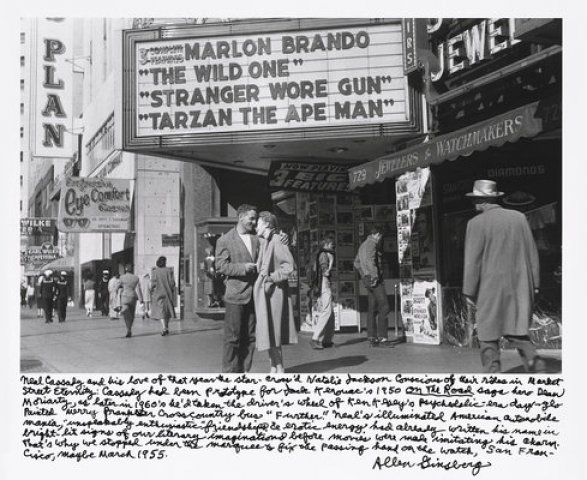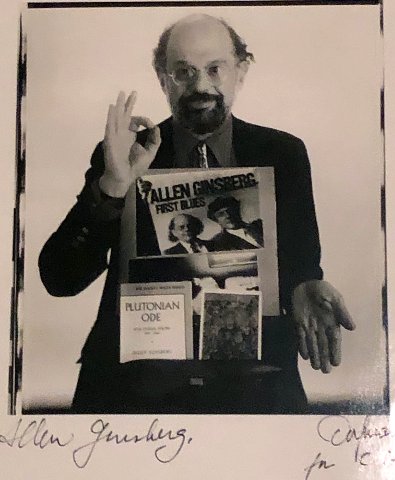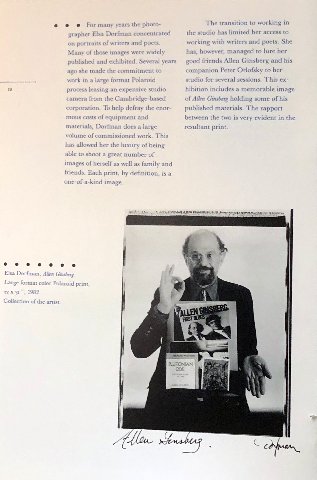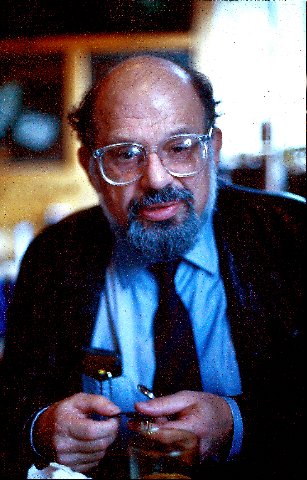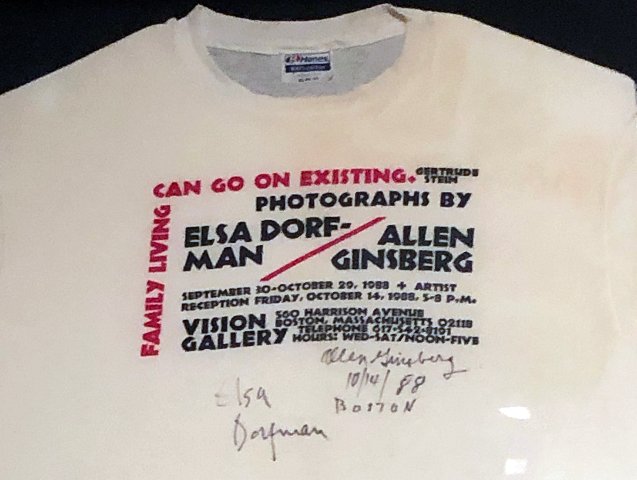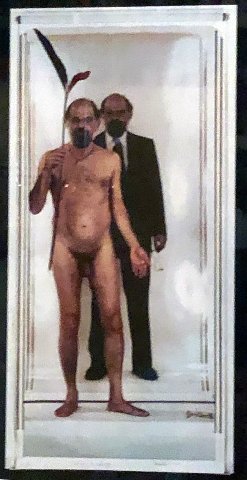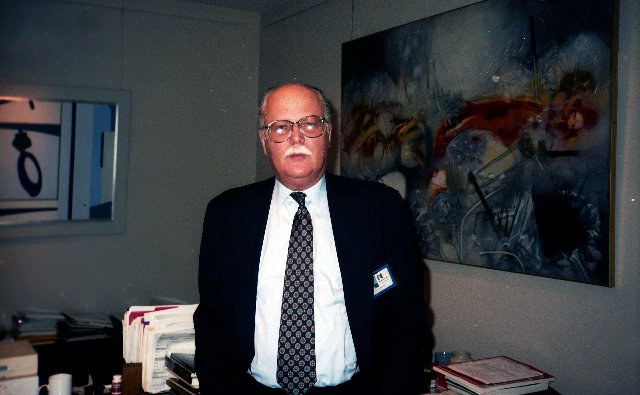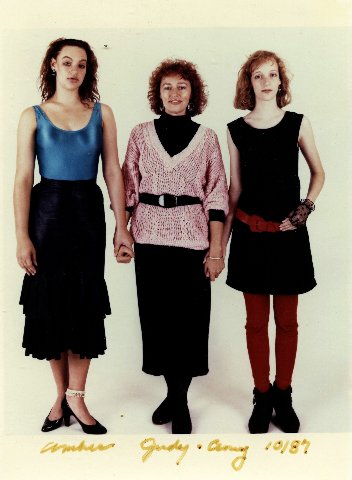Poloroid Photographer Elsa Dorfman at 83
Known for Studio Portraits Including Allen Ginsberg
By: Charles Giuliano - May 31, 2020
Of course, I never met the legendary leftist, Rosa Luxemberg, but, bet you dollars to donuts, she was a dead-ringer for the remarkable photographer, Elsa Dorfman. At 83 she died this weekend at home in the People’s Republic of Cambridge.
According to her husband, the civil-liberties lawyer Harvey Silverglate, the cause of death was kidney failure. She had been ill for the last year but attended her show at the MFA.
Back in the day we first interacted in Harvard Square. She would push a shopping cart, presumed to have been purloined, down Mass Ave from her house. It was redolent of her penchant for civil disobedience.
The cops told her to scram lacking the appropriate license to pedal. Harvey took it to court and pleaded that she was selling her art which came with constitutional coverage. He made similar arguments when hawkers pushed Avatar, which was regarded by the powers that be, as purveyors of hippie smut.
Elsa and Harvey were the surrogate, leftist, gonzo Mom and Pop dancing to the paradigmatic, Cambridge radical rag.
It is reported that she sold black and white prints for $2.50 each. But I recall forking over ten bucks, a lot for the time, for a vintage print of her pals Allen Ginsberg and Peter Orlovsky at home.
Back then, she was still doing house calls with a 35 MM camera. She even covered the Rolling Thunder tour of Bob Dylan which made a pit stop in Cambridge. Later, through Allen, she got back stage and showed some prints to Bob. He was not amused and that ended her life as an itinerant rock journalist.
The national headquarters of Polaroid was in Central Square, Cambridge. There were a number of projects with fine art photographers. The company had the Kennedy Gallery which curated the aesthetics of instant images. There was also a studio with large format cameras. Photographers came and worked with them.
There were about a half dozen 24 x24” format cameras. Elsa liked one so much she leased it. The large, bellows studio camera, and its sheets of instant developing prints, became her logo.
It also meant that she stayed put. By appointment, the world came to her. Eventually, she charged $5,000 for a portrait. Routinely she made two. The B-Side went to the client and the other went into her archive. Most of them are rather pedestrian if you have seen tons and tons of them. On average she had about 80 bookings annually.
Polaroid went into bankruptcy a couple of times so there were issues about the source materials.
Whenever Ginsberg came to town, he visited her studio. During one of those occasions I met with Allen for lunch in Harvard Square. He was about to visit the Great Barrier Reef. The poet was wearing two watches to tell time here and there or there and here as the case may be.
We then walked up Mass Ave to the studio where she was hard at work. There were a couple of large lights which she could wheel about. The subject was posed in front of a roll down white background. Often, clients came with props, kids with toys, ubiquitous balloons and stuff.
A blur of motion, with non-stop banter, she orchestrated the photo shoot to put the subject at ease. The intent was to create a natural authenticity from the sitter. In her radical-chic, thrift shop, schmatta attire, with running sneakers, she was the opposite of a temperamental artist. Having a portrait made was less like a session in the atelier and more like an artsy grocery store.
Curators and collectors loved her for it. Most of the buyers purchased their own images. The secondary market for that is unclear. But those many images of Ginsberg were another story.
Occasionally, she rented access to Polaroid’s largest camera. It was capable of producing a life-size, full-length portrait. She made a special double image of Ginsberg. First, she photographed him in street attire. Then he posed nude in front of the large print holding a flower. As I mentioned Elsa liked to use props.
Unquestionably, that double portrait of Ginsberg is her masterpiece. She offered it to the Museum of Fine Arts Boston. The director, Alan Shestack, took offense and turned down the gift. I reported that snub in Art News but it did not sway his decision. Elsa gave it to her son.
In 1988 I included her in a traveling exhibition “Here’s Looking at You: Contemporary New England Portraits.”
On the occasion of his birthday there is an annual Jack Kerouac Festival in Lowell. I planned an exhibition and programming in two parts. I organized an exhibition at New England School of Art & Design/ Suffolk University. Linda Poras curated a companion show for Brush Gallery in Lowell.
I had an agreement with Ginsberg’s NY Gallery, Tibor de Nagy, to borrow his work. Also, pieces were lined up with Elsa.
Just before the show Ginsberg died. The value of the work changed. The gallery wouldn’t lend and Dorfman withdrew. I managed to show a Ginsberg print I owned, as well as, a couple of Dorfmans. Poras borrowed several Dorfman prints from the Danforth Museum. Those Beat generation shows and projects were just amazing.
On another occasion Allen and Elsa showed together with Brent Sikkema Gallery which is now in NY. While in Boston the focus was on photography.
There was a t-shirt made for the occasion. I had Elsa and Allen sign it. Though I never wore it, I had it framed. Looking at it today it reminds me of when we were immortal and giants roamed the earth.



